24 March 2011
Welcome to the first installment of this new feature. The goal is simple: recommend the best hardware for playing retro games, based on issues like cost, video output, reliability, and functionality. Given that the PC Engine never made much of an impact outside Japan, very few people understand this console, so it seems like the perfect place to kick off this new feature.
#1 Wii Virtual Console Emulation
I know I'm going to take some flames on this one, so here's two important caveats: it pains me to make my top recommendation something other than original hardware, and one of the other projects I'm working on is a feature about how badly Nintendo squandered the potential of the Virtual Console. The PC Engine (renamed the TurboGrafx-16 for its American release) represents a special case, given the expensive cost of original games and hardware, as well as the confusing diversity in hardware and game mediums.
To put it succinctly, the cost of PC Engine games on the Wii Virtual Console is a hell of a bargain, compared to tracking down the original HuCards and CD-ROMs. Let's start by narrowing down the VC PC Engine library to the downloads that are actually worthwhile (something already covered for HuCards and CDs via the Wii system selector). Then, just to get a sense of the price range for originals games, we'll take the top 10 most expensive ones and least expensive ones, according to Video Game Price Charts, which—admittedly—has clear limitations, such as poor coverage of most CD-ROM games and import games, but at least it gives you an easy starting point. To get more current prices, I recommend checking out eBay.
Top 10 Most Expensive
|
$110 |
|
|
$102.50 |
|
|
$64.99 |
|
|
$63 |
|
|
$40 |
|
|
$40 |
|
|
$39.99 |
|
|
$35.50 |
|
|
$31 |
|
|
$26.50 |
|
Bottom 10 Least Expensive
|
$18.27 |
|
|
$15 |
|
|
$14.70 |
|
|
$14 |
|
|
$10.87 |
|
|
$10.34 |
|
|
$10 |
|
|
$8.50 |
|
|
$8.25 |
|
|
$7.49 |
|
As you scan through the above, recall that downloadable HuCards cost 600 points ($6) and CD games are 800 points ($8), plus the occasional 100-point surcharge for imports. That PC Engine titles are easily the best bargain on the entire Virtual Console service is patent.
Consider the special case of Castlevania: Rondo of Blood—an absolute must own title, and one of the best Castlevania games ever created. It regularly sells for $100+ on eBay. Buying the necessary hardware to play it will set you back an additional $150+. So let's assume (playing it conservative in cost) you drop around $250 for Rondo of Blood and the necessary hardware. You could just as easily have purchased a Wii and paid 900 Wii points ($9) to download Rondo of Blood—not to mention have money left over to grab a bunch of other bargain PC Engine downloads.
Currently, there are 63 different PC Engine games available on the American Wii Virtual Console channel. For some reason, the PAL territories are two games shy with 61. As for Japan, well since the PC Engine was much more popular there, and many of the best games were only available in Japan, gamers there have a whopping 125 titles to choose from! Yes, you will miss a ton of excellent Japan-only titles as an American/PAL Wii user, but you do score some clutch import titles like Star Parodier, Gradius II, Bomberman '94, Castlevania: Rondo of Blood, and Dai Makaimura (aka Ghouls 'N Ghosts—the lone VC SuperGrafx offering, but also the only mustpown title in its five-game library).
Now let's examine some of the obstacles with buying original hardware. The PC Engine hardware variations and game varieties are complex—find a simple guide here. In Japan, alone, there were eight different versions of the PC Engine hardware, and games could come in any one of five different mediums (there are even some hybrid CD-ROMs and HuCards, but it's not worth confusing this matter even more with them).
HuCard |
CD-ROM |
Super CD-ROM |
Arcade CD-ROM |
SuperGrafx HuCard |
Now explode your brain a little more with the fact that American and Japanese HuCards are shaped differently (i.e. region-locked) and Arcade CD-ROMs and SuperGrafx games were only released for Japanese hardware. Add to that the need to cope with old forms of video output, not optimized for modern televisions—the original PC Engine only supported RF, requiring the addition of the AV Booster or Backup Booster to gain composite output—and once again the Wii is a very convenient and affordable route to PC Engine nirvana, despite the limited game library.
#2 PC Engine Duo
If you're willing to contend with hardware and format trickiness, and you're cool with spending more money to get the ultimate set-up, then here's the best original hardware solution: Buy a PC Engine Duo. It comes in three variations.
PC Engine Duo |
PC Engine Duo R |
PC Engine Duo RX |
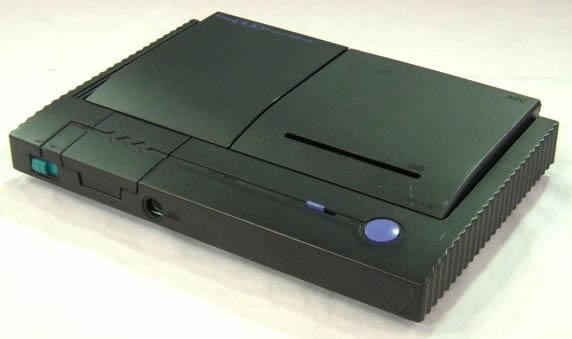 |
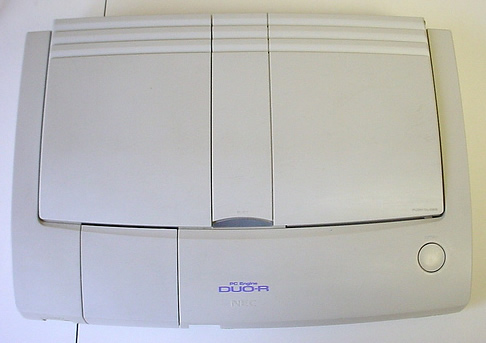 |
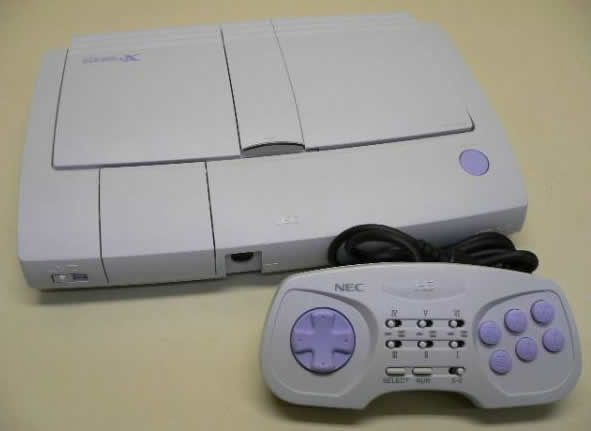 |
|
Differences between each version are very minor. The original PC Engine Duo includes a headphone port, which the Duo R and Duo RX lack, but the latter was the only one packaged with a six-button controller (essential for the incredible Street Fighter II port).
To appreciate all the wondrous elements that are packed into one piece of hardware, let's consider what you get beyond the capabilities of the original PC Engine:
Composite Output |
Memory for saving games and high scores |
CD-ROM compatability |
| Super CD-ROM compatability |
|
Another awesome aspect of the PC Engine Duo is that you can easily upgrade it to play Arcade CD-ROMs. All you need to do is get an Arcade System Card Duo (a HuCard that provides a big RAM boost).
You may be wondering, isn't the Japanese language barrier problematic with the PC Engine Duo? Well, it's a non-factor for CD-ROM games, because they're not region-locked, so you can play American CD-ROMs just as well as on a Turbo Duo (the U.S. version of the PC Engine Duo) as one the Japanese hardware equivalent. HuCards, on the other hand, are region-locked due to their different shapes and pin configurations, but being "stuck" with Japanese HuCards is actually an advantage. There's a much greater library (around 325, versus 94) of Japanese HuCard titles and hardly any RPGs or adventure games (the ones where Japanese language presents the biggest barrier) were ever localized for the United States in the first place.
#3 PC Engine CoreGrafx
PC Engine CoreGrafx |
PC Engine CoreGrafx II |
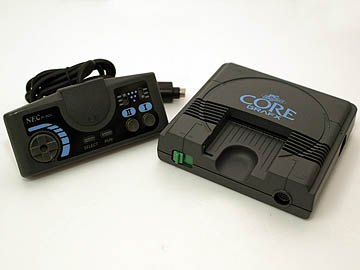 |
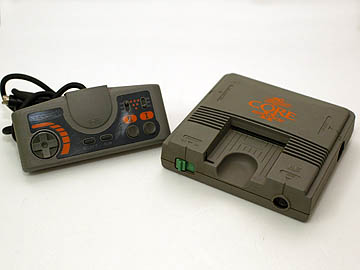 |
|
If your priority is playing HuCards at a reasonable price, this is where you want to start. The differences between the CoreGrafx and CoreGrafx II are even smaller than those that distinguish the PC Engine Duos—just the color scheme. Unlike the PC Engine, the Core Grafx comes with built-in composite video output, which is so much better than RF when using modern televisions.
Should you get bored of HuCards, you can expand to the next level by slapping on a PC Engine Super CD-ROM expansion (it includes the Super System Card 3.0). At that point, only an Arcade System Pro Card is keeping you away from Arcade CD-ROMs.
For the same reasons concerning game pricing and the superior Japanese game library already mentioned with the PC Engine Duo, the CoreGrafx is a better purchase than the TurboGrafx-16. The TurboGrafx-16 is already quite rare in the United States. People freak out when you show them one. Just imagine how they'll react to a CoreGrafx!
TurboGreat Significance
All these niggling issues of price and computability may obscure the unique significance of the PC Engine; it is easily one of the most criminally under appreciated consoles in the history of video games. There's something about the video color encoder that makes it stand out from all its 8-bit and 16-bit competitors, allowing it to display the most incredibly rich and lush colors. People argue that the PC Engine isn't a "true" 16-bit console, because it's CPU is really 8-bit. While that's true, it only makes the PC Engine more impressive. Not only did the PC Engine do a better job introducing the console world to CD-ROM games than the Sega CD, its shoot 'em up library dominated like-minded entries from the Sega Genesis and Super Nintendo—both representing allegedly superior hardware.
The PC Engine is a remarkable console, hard to find at a good value, hard to assemble, hard to deal with the myriad game mediums, but well worth the effort and likely to become a centerpiece of your retro video game collection. Hopefully this feature makes it easier for you to make it so. |